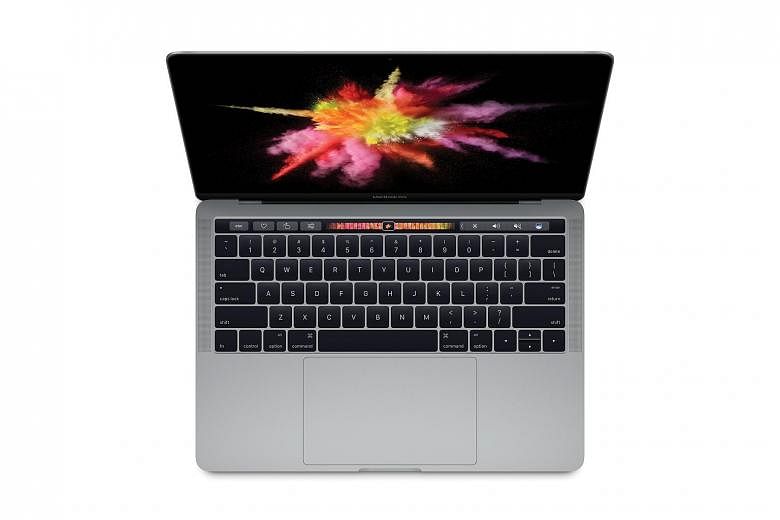The new, redesigned Apple MacBook Pro with Touch Bar - an organic light-emitting diode (Oled) touchscreen - and Touch ID fingerprint sensor are finally here.
Both the 13-inch (from $2,588) and 15-inch (from $3,388) models are available in space grey and the usual silver. We reviewed both.
DESIGN
The new MacBook Pro looks like an offspring of the old MacBook Pro and the newer 12-inch MacBook introduced last year.
Like the 12-inch MacBook, the new Pro has a metallic Apple logo on its lid. No more Apple glow. Lift the lid, and you find speaker grilles flanking the keyboard just like in the old MacBook Pro.
The speaker grilles are bigger on the 15-inch model compared with the 13-inch one. As a result, the sound quality is better with the bigger model, with more distinct mids and stronger bass. Even at maximum volume, I did not hear any crackling sound.

Both models use the second-generation butterfly mechanism - first found in the MacBook - for its keyboard, which is four times more stable than the scissor mechanism. The keys feel more responsive and have a better tactile feel than those of the MacBook.
The trackpad on the 15-inch Pro is twice as large as that of its predecessor, while the 13-inch Pro's trackpad is 46 per cent larger. This comes in handy when you need to move items across the screen.
In terms of side profile, the new 13-inch Pro is a uniform 14.9mm throughout (compared with MacBook Air, which tapers from 17mm to 3mm) and weighs 1.37kg (just 0.02kg more than the Air).
-
TECH SPECS (13-inch)
PRICE: From $2,588
DISPLAY: 13.3-inch, 2,560 x 1,600 pixels
PROCESSOR: Intel Core i5 2.9GHz dual-core (customisable up to i5 3.1GHz dual-core)
SYSTEM MEMORY: 8GB (customisable up to 16GB)
GRAPHICS: Intel Iris Graphics 550
STORAGE: From 256GB of flash storage
CONNECTIVITY: 4 x Thunderbolt
WEIGHT: 1.37kg
RATING
FEATURES: 4/5
DESIGN: 5/5
PERFORMANCE: 3/5
BATTERY LIFE: 4/5
VALUE FOR MONEY: 4/5
OVERALL: 4/5
TECH SPECS (15-inch)
PRICE: From $3,388
DISPLAY: 15.4-inch, 2,880 x 1,800 pixels
PROCESSOR: Intel Core i7 2.6GHz quad-core (customisable up to i7 2.9GHz qual-core)
SYSTEM MEMORY: 16GB
GRAPHICS: Radeon Pro 450 with 2GB of video memory (customisable up to Radeon Pro 460 with 4GB of video memory)/Intel HD Graphics 530
STORAGE: From 256GB of flash storage (customisable up to 2TB)
CONNECTIVITY: 4 x Thunderbolt
WEIGHT: 1.83kg
RATING
FEATURES: 4/5
DESIGN: 5/5
PERFORMANCE: 4/5
BATTERY LIFE: 4/5
VALUE FOR MONEY: 4/5
OVERALL: 4/5
The 15-inch Pro weighs 1.83kg and is 15.5 mm thick, which means it is thinner than the thickest part of the MacBook Air. A real candidate for MacBook Air upgraders.
THUNDERBOLT 3 PORTS
The SD card slot, HDMI and USB 3.0 ports are history. In their place are four Thunderbolt 3 ports - two on either end of the laptop - that also support USB-C. What does remain, surprisingly, is the 3.5mm headphone jack, sited on the laptops' right.
I think Thunderbolt 3 or USB-C is the way to go forward. You do not have to worry about plugging in cables and connectors the wrong way, and all the ports can be used for charging. Furthermore, the 15-inch Pro can connect to two 5K displays at the same time, while the 13-inch Pro can connect to two 4K displays simultaneously.
However, Apple should have included a USB-C to USB-A adapter as part of the package.
This way, I can at least charge my iPhone 7 Plus with the laptop.
The omission of the SD card slot is the more irritating issue, though, especially for photographers and creative professionals who use the MacBook Pro for their work.
That said, this is not something that adapters cannot solve (see other story on this page).
TOUCH BAR AND TOUCH ID
The Touch Bar is a long Oled touchscreen, with a resolution of 2,170 x 60 pixels and displaying millions of colours, that sits above the keyboard. It replaces the row of F1-F12 function keys, Escape key and Power button.
The virtual Escape key lights up on the far left of the Touch Bar when the laptop is powered up. At the far right end is the Touch ID fingerprint reader. This is also the Power button. During set-up, you will be asked to enrol your fingerprint.
Once this is done, you will be able to unlock the laptop with Touch ID, just like with the iPhone, and also unlock locked Notes and confirm iTunes purchases.
By default, the Touch Bar will display the standard system controls, such as display brightness, keyboard backlight, media controls, system volume and Siri. But you can customise it to your liking.
The Touch Bar looks sharp and feels very responsive, whether you are tapping on a button or sliding on a brightness setting. You get the same number of icons on the Touch Bar, regardless of which model you choose.
Contextual commands will appear on the Touch Bar when you are using a supported app. The system controls will collapse to the right of the Touch Bar, with an arrow for you to expand them again.
All the native Apple apps, such as Mail, Safari and Photos, support the Touch Bar. In Mail, you get commands such as Archive, Move To and Flag.
I find the Touch Bar more useful in Photos. The thumbnail pane allows you to browse through the thumbnails by sliding your finger along the Touch Bar. You can also simply tap on the photo you want. In Safari, you can move between tabs using the same sliding action.
There are not many apps that support the Touch Bar right now. I tried two that do so - photo editor Pixelmator and deejay app djay Pro.
For Pixelmator, you get the various tools on the Touch Bar.
For example, you can adjust the size of the paint brush by sliding on the Touch Bar.
The djay Pro app lets you slice a track, apply filters and effects in real time when you are creating loops. It is quite fun to do all that on the Touch Bar. I think this is where the Touch Bar truly shines. Apple needs more killer apps like this.
PERFORMANCE
With a faster processor and its discrete graphics processor, the 15-inch Pro feels zippier than the 13-inch Pro whether you are working on spreadsheets, editing photos or creating audio loops.
In the software benchmark test GeekBench 4, the 15-inch Pro clocked 4,290 (single-core) and 13,322 (multi-core), while the 13-inch Pro clocked 3,877 (single-core) and 7,549 (multi-core). Both are not much faster than their predecessors.
Playing of the action role-playing game Diablo III at its maximum resolution for each model is smooth with all graphics settings switched to High. But, at times, there are slight screen tearing artifacts on the 13-inch model.
In terms of battery life, the 13-inch Pro lasted 6hr 8min in our video loopback test. The 15-inch Pro lasted 6hr 40min. Again, the battery lives of both do not differ much from those of their respective previous models.
•Verdict: The new Apple MacBook Pro's Touch Bar is not revolutionary, but certainly a good thing to have. If you want something more portable, the 13-inch model is for you. If you want a high-resolution big screen and more powerful machine with discrete graphics, get the 15-inch model. That is my choice as well.



